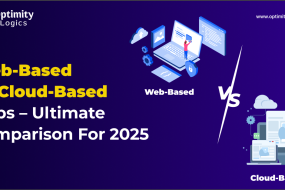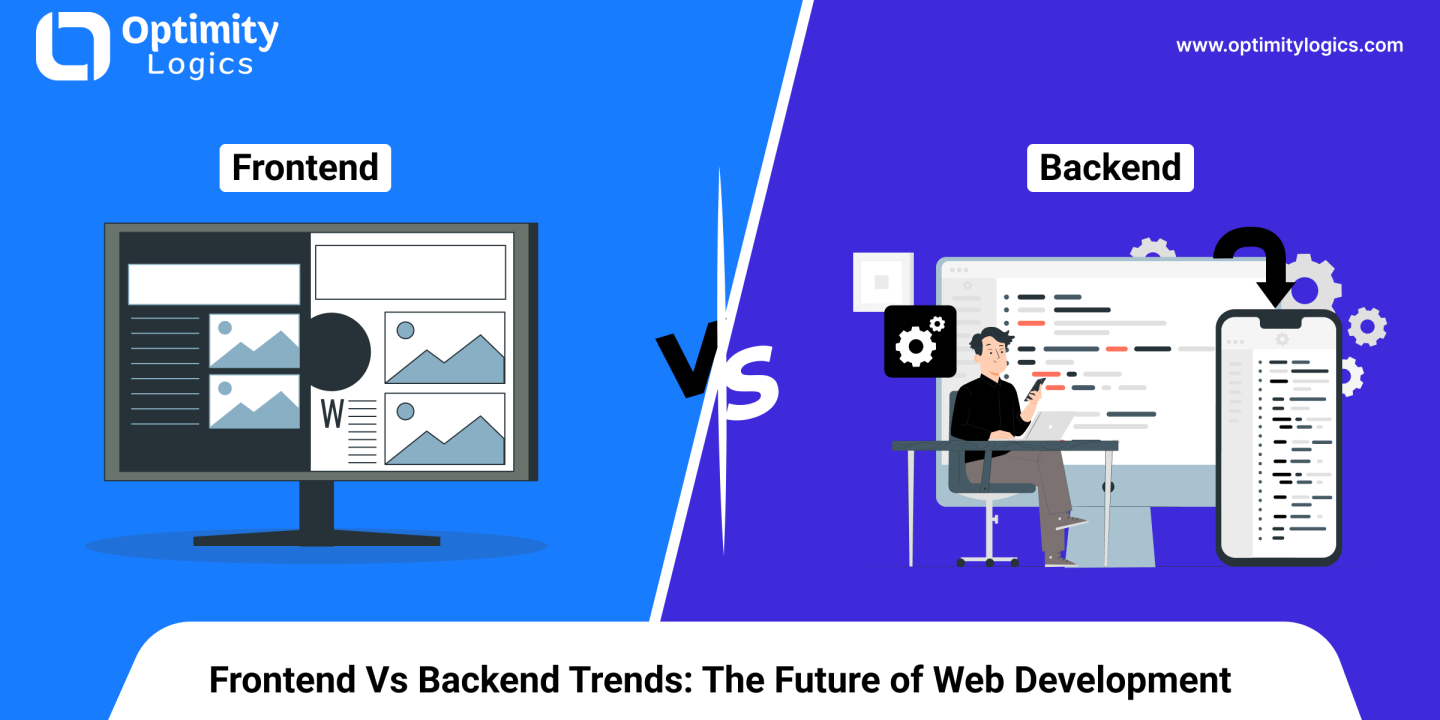
Frontend Vs backend are the two most popular terminologies used in the niche of development. Websites consist of two parts: the front end, which users experience, and the back end, which comprises the invisible structure making the front end possible. The difference between front-end and back-end development can seem confusing, given their similarities in making websites function properly. Together, these trends shape the future of web development, pushing boundaries in innovation and functionality.
In this blog of frontend and backend trends, Optimity Logics will uncover the emerging technologies and practices shaping the future of web development. Of course, professionals and experts in the niche of frontend development services or backend development services can assist you.
But, if you are struggling with the same query and are curious to understand the actual differences, we’ve got you covered here in this blog. Without delay, let’s get started.
What Is Frontend Development?
Frontend development focuses on creating a website or application’s visual and interactive components that users interact with directly. So, It involves the design, structure, and behaviour of web pages, ensuring a seamless and engaging user experience. Frontend developers use a combination of languages and technologies, such as HTML for structure, CSS for styling, and JavaScript for interactivity.
To guarantee that websites’ user interfaces appear and work correctly, front-end development calls for both technical know-how and inventiveness. Front-end devs work with back-end developers, designers, and user experience analysts.
A bachelor’s degree in web design, programming, computer science, & graphic design is normally requires for front-end developers. Some people acquire these abilities through prior employment, coding boot camps, or projects in order to obtain a job without going to school.
Alright! A “static” website is one that doesn’t let users do anything, like a basic landing page or a minimalist business website. Front-end developers are in charge of developing features such as:
– Graphics
– Symbol, Arrow, Circle, Line etc…
– Navigational Design Component
– Animated Gifs
– Management Of Content
Frontend Technologies
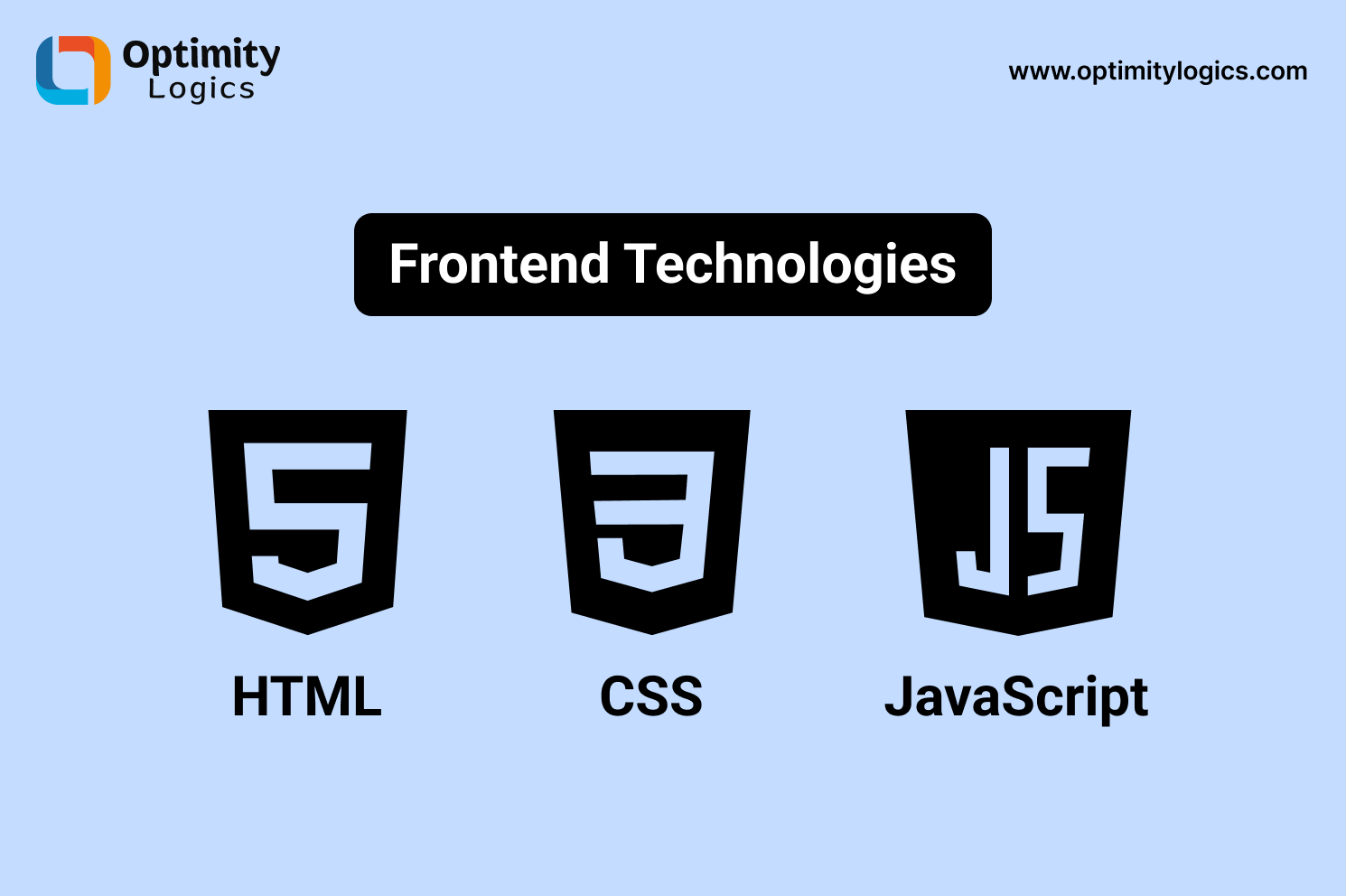
Frontend development relies on three core technologies—HTML, CSS, and JavaScript—to create interactive, visually appealing, and functional user interfaces. Also, Each plays a distinct role in building the frontend of websites and applications:
– HTML
HTML is the foundation of any web page and is responsible for defining the structure and content. It uses tags to specify elements like headings, paragraphs, images, links, and forms. So, HTML provides the basic skeleton of a webpage, making it possible to organize and display content in a meaningful way
– CSS
CSS is used to style and format HTML elements, allowing developers to enhance the visual presentation of a web page. It controls aspects such as colours, fonts, spacing, layout, and responsiveness. Also, With CSS frameworks like Bootstrap or preprocessors like SASS, developers can streamline styling processes and create modern, consistent designs across devices.
– JavaScript
JavaScript adds interactivity and dynamic behaviour to web pages. It enables features like dropdown menus, form validation, animations, and real-time updates without refreshing the page. Popular JavaScript frameworks and libraries like React, Angular, and Vue.js further simplify development by providing reusable components and robust functionality.
Together, HTML, CSS, and JavaScript form the backbone of front-end development, empowering developers to create engaging and user-friendly web experiences.
Frontend Framework
Frontend frameworks simplify the process of building modern web applications by providing reusable components, structured workflows, and efficient tools for managing user interfaces. So, Among the most popular front-end frameworks are React, Vue, and Angular, each offering unique features to address various development needs.
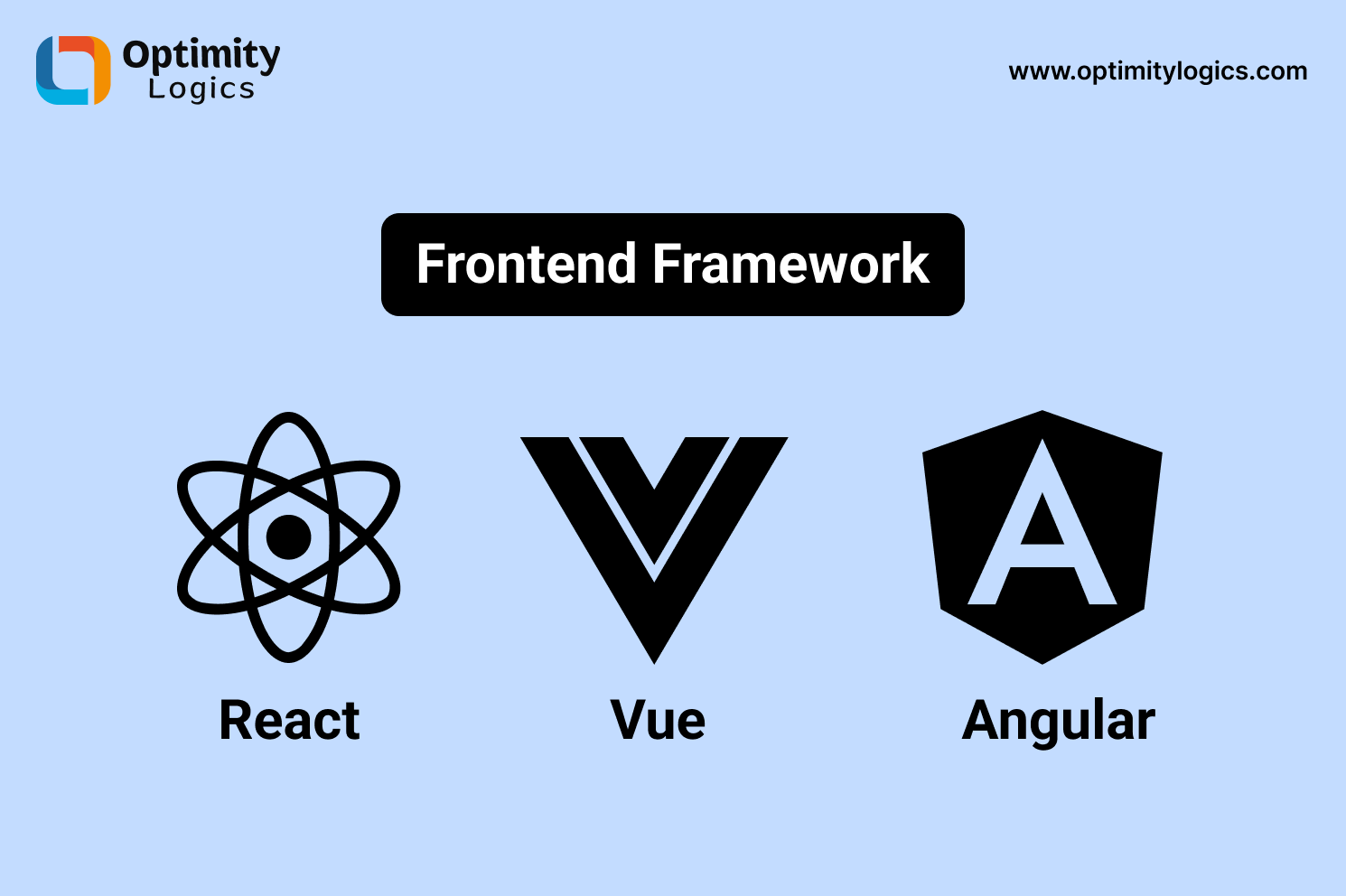
– React
React is a JavaScript library for building user interfaces, known for its simplicity and flexibility. It uses a component-based architecture, allowing developers to create reusable UI components. So, React‘s Virtual DOM ensures high performance by efficiently updating the user interface without reloading the entire page.
React is best for large-scale, interactive, and dynamic web applications such as social media platforms or e-commerce sites.
– Vue
Vue is a progressive JavaScript framework designe for building UIs and single-page applications. It’s lightweight, easy to learn, and combines the best features of React and Angular. Also, Vue provides a reactive data-binding system and a clear structure, making it beginner-friendly yet powerful for complex projects.
Vue is best for small to medium-sized projects, as well as applications requiring smooth integration with existing projects.
– Angular
Angular is a full-fledged framework for building web applications. It uses TypeScript, a superset of JavaScript, and offers a complete solution with built-in tools for routing, forms, and state management. So, Angular’s two-way data binding simplifies synchronization between the UI and application logic.
Angular is best for enterprise-level applications with robust requirements and scalable architecture.
What Is Backend Development?
Backend development refers to the server-side processes that power a website or application, focusing on managing and processing data, handling requests, and ensuring seamless communication between the server, database, and front end.
Unlike frontend development, which is user-facing, the backend operates behind the scenes to ensure functionality and performance. Also, These professionals create a site’s operations, databases, and application programming interface (API).
The back end includes an application, server, and database. Computer users often do not see the elements of back-end development, which remain below the hood of a website.
Back-end devs use tools like SQL Server and Oracle to store, organize, and change data. Employers often require expertise with PHP frameworks, version control software, and debugging back-end systems and applications. Also, Back-end devs collaborate with front-end developers, management, and business stakeholders to understand each project’s goals.
Backend Technologies
Backend development relies on a variety of technologies, including programming languages, frameworks, databases, and tools that work together to manage server-side logic, data processing, and communication with the front end. Below are the backend technologies:
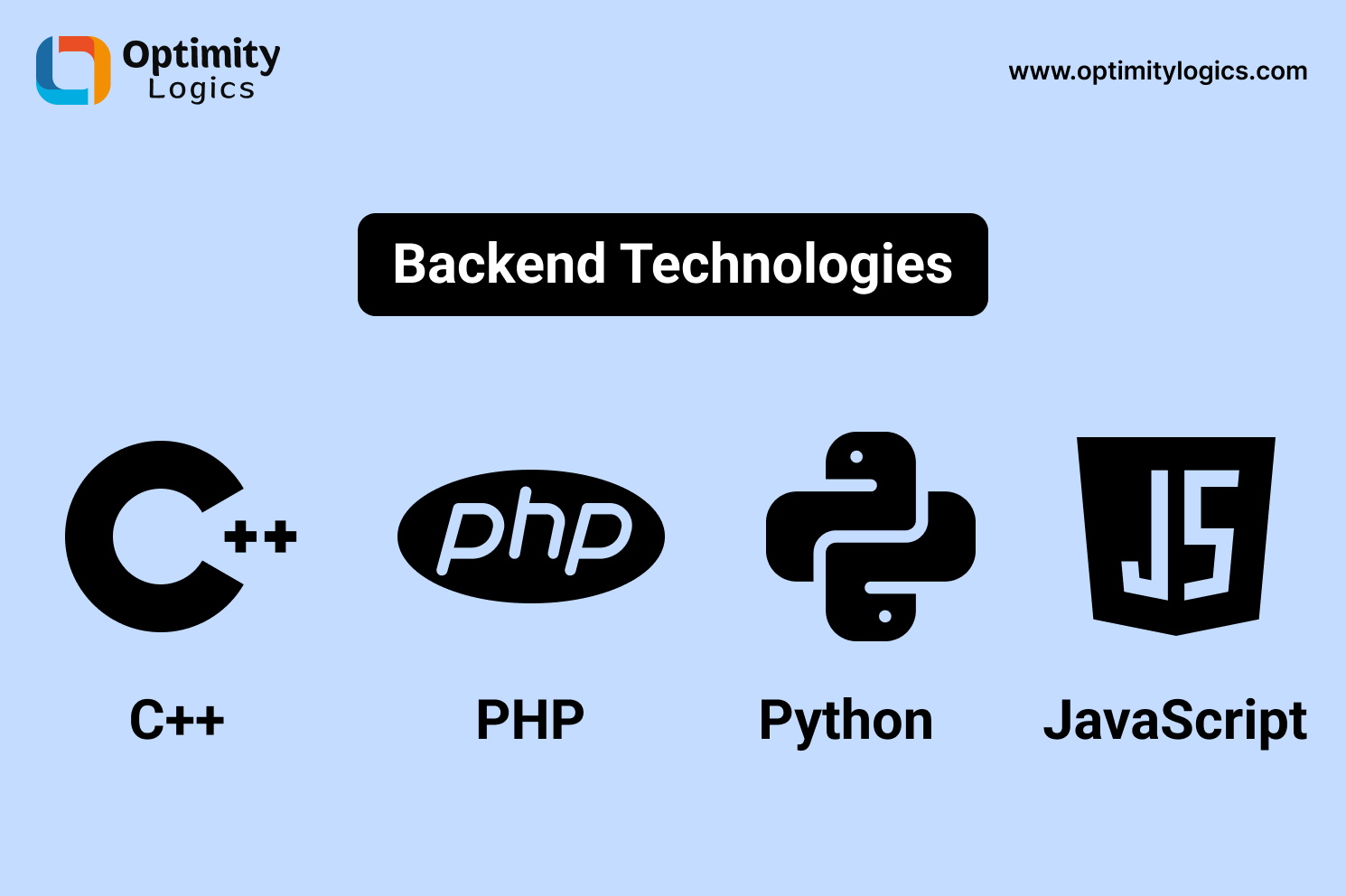
– C++
C++ is a powerful, high-performance, and versatile programming language that is widely use in backend development for systems where performance, resource management, and real-time execution are critical.
Building large-scale, resource-intensive programs, such as server-side systems, game engines, and real-time applications, is made easy with C++, which is well-known for its effectiveness and adaptability.
– PHP
PHP (Hypertext Preprocessor) is a popular server-side scripting language widely used for backend development. It is especially known for its simplicity, ease of integration with databases, & suitability for building dynamic and interactive web applications. So, PHP powers many websites, including large-scale platforms like WordPress, making it a cornerstone of modern web development.
– Python
Python is a versatile, high-level programming language that has become a top choice for backend development due to its simplicity, readability, and robust ecosystem. So, Known for its clean syntax and extensive libraries, Python is ideal for building scalable, secure, and efficient server-side applications.
– JavaScript
While JavaScript is widely recognize as a cornerstone of frontend development, its capabilities in backend development have grown significantly, especially with the advent of Node.js. JavaScript’s ability to handle both client-side and server-side programming makes it a powerful language for full-stack development, simplifying workflows and enabling seamless communication between the front end and back end.
Backend Framework
Popular backend frameworks are often design to be flexible, scalable, and secure, helping developers create high-performance and maintainable systems more efficiently.
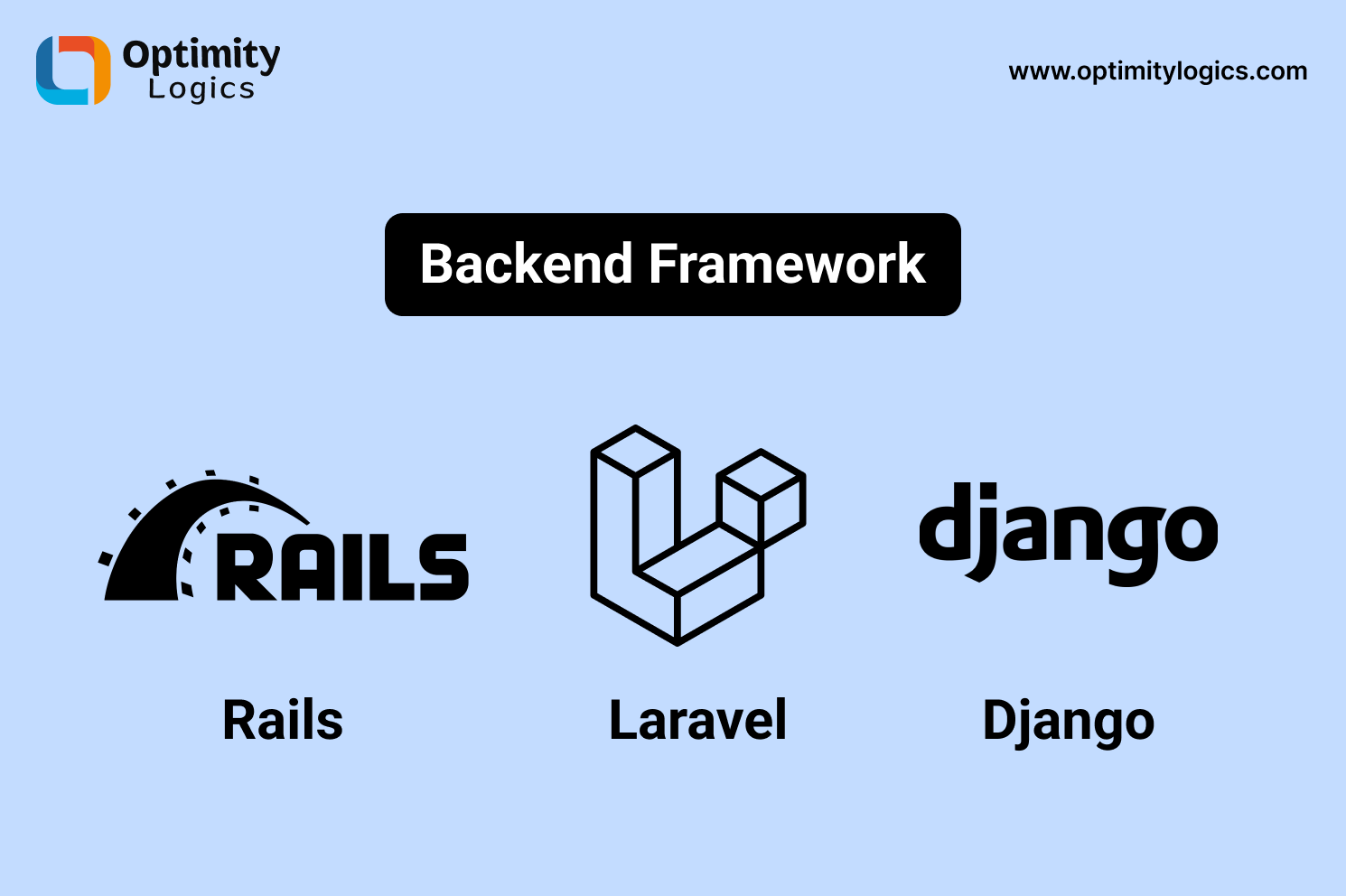
– Rails
Ruby is a powerful, full-stack web application framework written in Ruby. It follows the Model-View-Controller (MVC) architecture, which helps organize the structure of the application by separating the data model, user interface, and control logic. Also, Rails is design to make backend development faster, more efficient, & easier to maintain by providing pre-built tools and conventions for common tasks like routing, database management, and user authentication.
– Laravel
Laravel also offers a variety of ways to access relational databases, as well as application management and deployment tools. The source code for Laravel is accessible on GitHub and is licens under the MIT brand.
It comes with a specific dependency manager and a modular packaging mechanism. Laravel is regarded as one of the top web frameworks, and some experts believe it is the best backend development software available. For professional assistance with the framework, hire backend developers, as the experts are well-versed in the same.
– Django
Django is a robust Python framework used to develop seamless, pragmatic, and clean web designs. It is one of the most user-friendly open-source backend frameworks for creating sophisticat and feature-rich database-driven websites. Django is a backend web development framework that is widely regard as one of the best.
Frontend Vs Backend Development
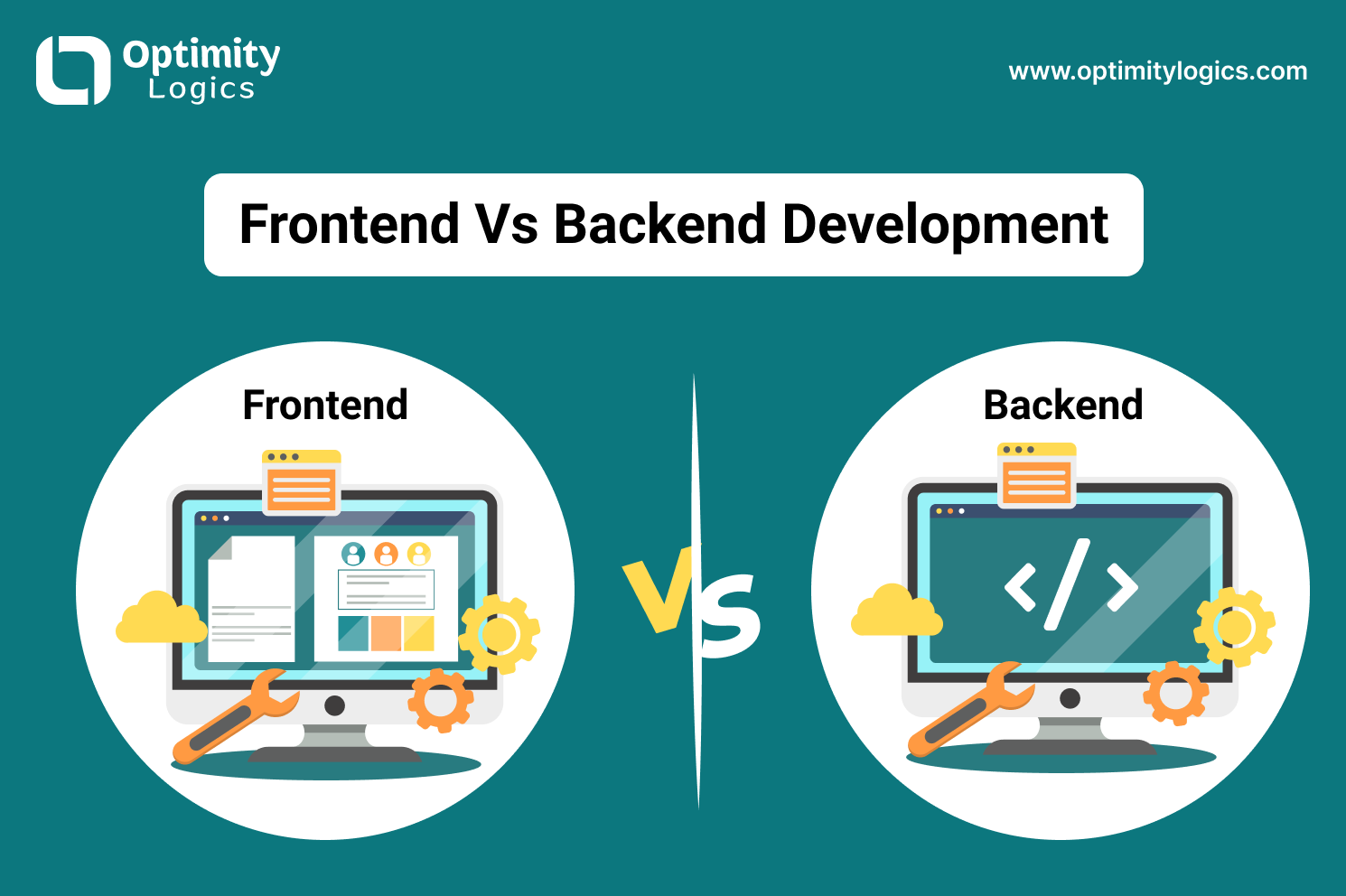
Frontend vs Backend Development refers to two distinct yet interconnected aspects of web development. So, Optimity Logics are simplify the differance. So, Continue reading and enjoy more!
| Aspects | Frontend | Backend |
| Definition | Front-end development involves the visual components within a website/app | Back-end development involves the implementation of databases and other server-side assets |
| Skill Required | HTML, CSS, SASS, JavaScript | Ruby, Python, PHP, JavaScript |
| Independent | Cannot work independently of the back-end structure | Works independently of the front-end structure |
| Goal | Accessibility and visual appeal | Scalability and low latency |
| Framework | Angularjs, Reactjs, Vuejs | Django, Laravel, Ruby |
| Additional Skill Requird | UI/UX design proficiency | Analytical and problem-solving approach |
To Wrap Up,
As web development continues to evolve, both frontend and backend technologies are advancing at a rapid pace, shaping the way applications are built and experienced. The future of web development will see increasing convergence between frontend and backend, with tools and frameworks that enable seamless interaction between the two.
Frontend technologies will continue to focus on delivering more dynamic, interactive, and responsive user interfaces, while backend systems will prioritize scalability, security, and performance. Bringing a leading software development company on board can prove to be a game-changer.
Understanding these trends and adapting to new tools and practices will be crucial for developers to stay competitive and build the next generation of web applications.


